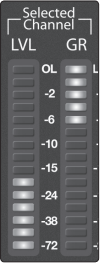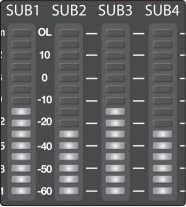StudioLive metering - dbFS vs. dbu
StudioLive-series mixers meter the channels and the main and subgroup
buses using two different reference scales. The channel levels are measured
in dBFS and the output levels are measured in dBu. To understand how
this impacts the metering on your StudioLive, you must first be aware of
the difference between dBu and dBFS and how both are measured.
dB is an abbreviation for “decibel.” One decibel is equal to one-tenth of a Bel.
When a measurement is stated in dB, it is describing the ratio between two
levels: the level being measured and the level being referenced. Without
a reference point, the absolute dB value cannot be determined.
dBFS, or “decibels relative to full scale,” is used to measure amplitude levels
in digital systems that have a maximum peak level (the point at which
the A/D converter will clip). When measuring in dBFS, 0 dBFS cannot be
exceeded. 0 dBFS can equal +10 to +24 dBu, depending on the device’s
maximum peak level. For StudioLive-series mixers, 0 dBFS equals +18
dBu in the subgroups and +24 dBu in the main output meters.
dBu measures decibels relative to 0.775 volts with an open or unloaded circuit. (The
“u” in “dBu” stands for unloaded.) While 0.775 volts may seem rather arbitrary, it is the
voltage level that delivers 1 mW in a 600Ω resistor, which is the standard reference
impedance in a telephone audio circuit. (The Bel was named after Alexander
Graham Bell). Because the StudioLive subgroup and main outputs are electrical,
rather than digital, it is more advantageous to meter them relative to voltage.



The Subgroup and Main meters display signals from -60 to +18 dBu (-78 to
0 dBFS) and -60 to +24 dBu (-72 to 0 dBFS). The StudioLive channel meters
display signals from -72 to 0 dBFS. This means that the Subgroup meters will
display 6 dBu of signal before your channel meters will register a signal.
If you have multiple channels set to unity and routed to the Subgroup and Main
buses, you will see even more signal in your output meters. Every time you double
the channel count, you add 3 dB more signal to the bus. So if you have 16 inputs
set to unity and routed to a subgroup and to the mains, you will see 12 dB more
signal level than you would if only one channel were routed. This means your
subgroup fader meter could be registering -58 dBu, and your Main meters will
display -52 dBu of signal, but your channel meters still won’t display anything.
By now you’re probably wondering just how loud -78 dBu is. Imagine
walking into the vocal booth at your favorite professional recording
studio and closing the door. The ambient noise of a very quiet room, like
a professional vocal booth, is around -80 dBu. Humans perceive a noise
level doubling about every 10 dBu. So -78 dBu is pretty quiet.